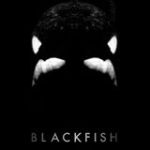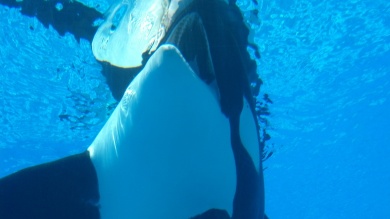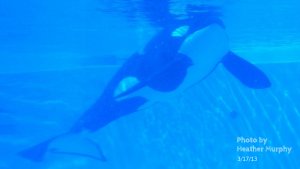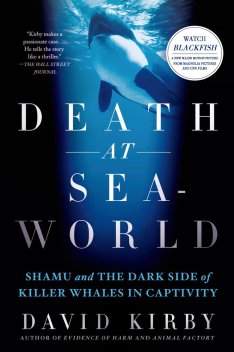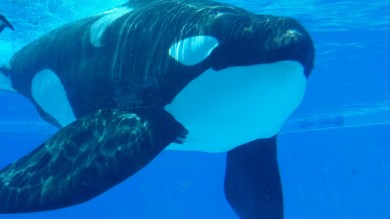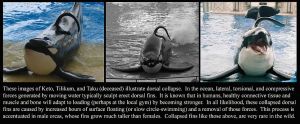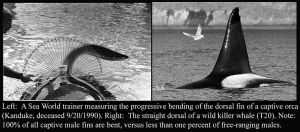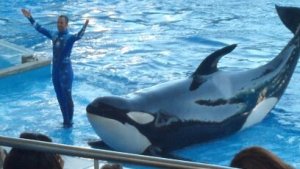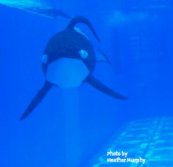
To sign this important petition, click here: http://www.change.org/petitions/seaworld-end-captive-orca-breeding-program
This is a call to action to end the captive breeding programs at SeaWorld Parks. SeaWorld continues to boast about their “successful breeding program” when in all actuality that is far from the truth. There have been thirty-seven known pregnancies at SeaWorld parks since the first captive birth in 1985. Only eighteen of these calves still alive today, barely half. The captive breeding program at SeaWorld has resulted in 6 stillbirths, two miscarriages, and five maternal deaths during childbirth. One remaining calf is a result of inbreeding.
The five females who have died during, or shortly after, birth experienced very unnatural circumstances.
One of the most disturbing was that of Gudrun. When Gudrun went in to labor in February 1996, a pulse could not be found on the unborn calf who was presumed dead. Since she was not delivering the calf, they needed to pull it from her.
David Kirby writes in Death at SeaWorld:
The pain must have been unearthly. Gudrun began to hemorrhage severely. Her dorsal fin collapsed, probably due to dehydration. She refused to eat and ignored all attempts by people to make contact with her. She remained motionless in one spot, unprotected by shade, so staff lovingly lavished her back with zinc oxide. After the bleeding stopped, Gudrun stayed that way for four days as her worried caretakers did all they could to nurse her back to health.
On the fourth day, Gudrun finally moved. She slowly swam over to the gate where her disabled young calf, Nyar, was watching. Nyar had had to be separated from Gudrun after the mother began attacking her daughter. Now Gudrun gently nudged Nyar’s rostrum through the bars, as if to ask for an overdue rapprochement. Gudrun died a few hours later.
Many times, mothers reject their calves either due to having them at a young age, spaced too close together, or not having the experience necessary to care for them properly.
In “Keto and Tilikum Express the Stress of Orca Captivity” by Drs. John Jett and Jeff Ventre, they state:
At SWF (SeaWorld Florida), Taima was a notoriously poor mother as well. She died from a prolapsed uterus while giving birth to her fourth calf on 6 June 2010, at the age of 20. Keep in mind that killer whale gestation is approximately 18 months in duration, and to eiterate, wild Northern Resident calves are “born at five-year intervals.”
Gudrun rejected her first calf, Nyar, who was born with a birth defect. Kayla also rejected her calf, Halyn. Halyn was bottle-fed every two hours around the clock by staff. Taima rejected Sumar as well.
The paper goes on to list other stress factors of killer whales in captivity and their impact on each other and those who work with them.
The practice of keeping killer whales in captivity has proven to be detrimental to the health and safety of animals and trainers alike. Captured animals are confined to small, acoustically-dead, concrete enclosures where they must live in extremely close proximity to other whales with which they often share no ancestral, cultural or communication similarities. The resultant infighting amongst captive orcas is exacerbated by virtue of having no place to run, as confinement fails to provide spatial escape options that natural settings offer.
One of the most notorious of these fighting incidents was that of Kandu V in 1989. The incident is described in Death at SeaWorld:
Kandu had been resting in the back of the pool with her one-year-old calf, Orkid, along with Corky. Corky had shown undue interest in the calf, something that had agitated Kandu intensely. Though younger and smaller than the twenty-five-year-old Corky, Kandu exerted dominance over her from the beginning.
Kandu slammed her head into Corky, severing a major artery in Kandu’s upper jaw. Blood stained the back of the pool and a ten-foot geyser of crimson spouted from Kandu’s blowhole. Over the next forty-five minutes Kandu bled to death as SeaWorld staff and the audience looked on in helpless distress.
In the wild, these whales travel hundreds of miles with the whole ocean at their disposal. When enclosed in a small area, there is nowhere to run.
SeaWorld started their captive breeding program claiming it had educational value. While the early breeding did give researchers valuable information such as the length of gestation time, there has not been a new source of research or education in quite some time. The latest work cited in their Animal profiles is 13-years-old. Since then, more recent publications have shown this information to be inaccurate, or false, in most cases. SeaWorld is no longer a reliable source of educational information.
Dental care is another stress-related, or boredom, issue of captivity reported in the paper. The whales break their teeth by biting on the horizontal metal bars between tanks. This could be “jaw popping” as an act of aggression or chewing as a result of boredom. Either way, it results in broken teeth, which then need to be drilled out to prevent exposure of pulp. To treat this, a hole is drilled through the pulp using a variable speed drill. Once the procedure is complete, the holes must be irrigated 2-3 times per day for the rest of the whale’s life.
Some whales are treated with Tagamet, the same medication given to humans, for stress-related ulcers. Although SeaWorld states that this is common, I’ve never heard of a whale in the wild taking Tagamet, have you?
The dorsal fin flop is also a “side-effect” of captivity, particularly for males. Although some form of bend is possible in the wild, it is only common in 1%. Captive males have a 100% flop.
Two deaths at SeaWorld in particular would have certainly not occurred in the wild. Those are the deaths of Kanduke and Taku.
In Dr. Jett and Dr. Ventre’s paper, “Orca captivity and Vulnerability to Mosquito-Transmitted Viruses” they write:
Since orcas (Orcinus orca) were first placed into captivity for entertainment purposes serious health issues related to their captivity have become apparent. Among these, mosquito-transmitted diseases have killed at least two captive orcas in marine parks in the United States. Kanduke, a 25- year-old male orca, died suddenly in the summer of 1990 at SeaWorld of Florida in Orlando. Necropsy results identified St. Louis encephalitis virus (SLEV) as the cause of death (7). Subsequently, Taku, a 14-year-old male orca, died suddenly and without notable premonitory signs of illness in 2007 at SeaWorld of Texas in San Antonio. The necropsy results also confirmed the presence of West Nile Virus (WNV) in brain tissue, with observed lesions consistent with those caused by WNV in other animals (42). An extensive record of mosquitoes feeding on zoo animals exists (1), and mosquitoes may exhibit altered host preferences within zoo settings (44).
Based on prior experience and observations working directly with captive orcas at a marine park in Florida (U.S.), we identify several factors that could place orcas held in U.S. theme parks at increased risk of exposure to mosquito-transmitted viruses, as well as an increased risk of developing the manifested diseases from these viral pathogens. Our animal trainer experience includes thousands of cumulative hours conducting “night watch” observations of captive orcas held in Orlando, Florida. Night watch duties at this park included recurrently documenting killer whale respirations for five minute intervals, and simultaneously noting the orcas’ behavioral patterns from night until morning (typically 10:00 p.m. until 6:00 a.m.). We routinely observed long periods of logging behavior during night watch duties at the park, which coincided with the presence of biting mosquitoes.
Another mosquito-related death is also possible. In June 2008, Halyn died of encephalitis in San Antonio. While there are other factors that could have caused the encephalitis other than mosquitoes, it is very likely that it was. A monk seal in the same park died of West Nile Virus at around the same time. Halyn was less than three years old at her time of death.
Other current problems that make for good reason to stop the breeding program would be the limited gene pool.
Tilikum has now been responsible for siring seventeen pregnancies since he came to SeaWorld Orlando in January 1992. Three of these calves, still owned by SeaWorld, are currently on breeding loan at Loro Parque. The gene pool is shrinking. The last calf born in San Diego was sired through artificial insemination by Kshamenk, a whale held in Marina Mundo in Argentina.
Of all whales to choose from for breeding, Tilikum would be the one obvious choice NOT to procreate further if common sense applies.
With Tilikum responsible for the deaths of three people, it’s obvious that these whales have aggressive tendencies in captivity. Tilikum has not been the only whale to lash out at his trainer. The first documented aggression took place in San Diego in 1971 when Shamu thrashed his “rider” off, grabbing her by the leg and carrying her to the bottom of the pool.
The year 1987 was a dangerous year to be a SeaWorld trainer. In March, a trainer in San Diego was attacked by multiple whales. He spent nine days in the hospital with a ruptured kidney among other injuries. In June, Kandu landed directly on top of a trainer causing a broken neck and permanent loss of head movement. Later that summer, another trainer was rammed in the stomach which sent her to the hospital.
But November 21 was the most dangerous yet. John Sillick was riding on Nootka I when Orky II slammed down on top of him. It took 6 operations over 12 months to put him back together again with 3 lbs of pins, plates and screws including a plate in his pelvis. All vertebrae in his neck had to be permanently fused.
June 12, 1999, an experienced trainer named Ken “Petey” Peters was doing a show with Kasatka and Takara. Takara unexpectedly split to the back tank during the performance. Kasatka then left Peters in the water and began circling the perimeter of the pool at high speeds. She then opened her jaws wide, moved in to grab his legs and tried to push him out of the pool. Fortunately he was pulled from the pool by the spotter.
In 2006, Kasatka showed herself again…twice. On November 15, Brian Rokeach was doing water work with Orkid for the first time. Three other trainers were onstage, including Ken “Petey” Peters, who had already experienced aggressive incidents with Kasatka in 1993 and 1999. Rokeach had just completed a ride with Orkid and she was on one end of the pool. The trainers called Orkid and Sumar back to the stage and they dove under the surface. Rokeach started to swim back to the stage when Orkid sneaked up behind him and grabbed his left ankle. Orkid did a barrel roll, pushing him all the way to the bottom of the pool. After several calls, the whales finally returned back to the stage and Rokeach was pulled from the water with the help of the trainers. He suffered a torn ligament in his ankle, which took a lot of physical therapy for him to recover.
The most notorious incident occurred on November 26. Ken Peters called on Sumar and Kasatka to perform much of the water work in the show. Orkid was not doing waterwork because of the previous incident and Corky had been put on light duty after being raked by Kasatka.
Kalia, Kasatka’s newest calf, was backstage getting rowdy in one of the pools. Kasatka began the segment perfectly. As he dove under the water to meet with the whale, he suddenly heard a loud whale vocalization, sounding like a distress call or cry. Kasatka instantly grabbed his ankles, pulling him underwater for several seconds. When he surfaced, she began “rag-dolling” him, taking him under again for a minute or more. She slowly brought him up to the surface, where he yelled for help, before she took him back down again. As she brought him up, he told his colleagues not to recall her since it only made her bite down harder. He gently stroked her in an effort to calm her down.
A trainer threw “scubacuzzi” onto the surface. Keeping Peters in her mouth and away, Kasatka went over to inspect the object. Staff deployed a net as the audience was ushered out. Kasatka let go of Peters to inspect the net before grabbing his foot again, this time pinning him to the bottom for a minute or more. Finally she grabbed him, brought him to the surface and let go. He backed away slowly, then quickly turned away towards the stage. She charged at him again, but the other trainers grabbed him and pulled him to safety.
Ken Peters suffered puncture wounds to both feet and a broken metatarsal ligament in his left foot. He was transported to the hospital for surgery and three days of antibiotics to prevent infection.
There is no denying the evidence that these killer whales do not cope well in captivity. Period. Stillbirths, miscarriages, calf rejection, dental care, dorsal fin collapse, ulcers, encephalitis, infection and aggression towards themselves or trainers all point to captivity. It’s time to stop spreading the horror. It’s time to give a true education of what these whales’ lives are like in their natural habitat. End captive breeding now.
Sources:
Death at SeaWorld by David Kirby can be found at http://www.amazon.com/Death-SeaWorld-Killer-Whales-Captivity/dp/1250002028/ref=sr_1_cc_1?s=digital-text&ie=UTF8&qid=1319656181&sr=1-1-catcorr
“Keto and Tilikum Express the Stress of Orca Captivity” by Dr. John Jett and Dr. Jeff Ventre can be found http://theorcaproject.wordpress.com/2011/01/20/keto-tilikum-express-stress-of-orca-captivity/
“Orca Captivity and Vulnerability to Mosquito-Transmitted Viruses” by Dr. John Jett and Dr. Jeff Ventre can be found most recently http://blog.chron.com/sciguy/2013/05/are-mosquitoes-a-secret-killer-whale-killer/
Dates of births and deaths were found on various pages of http://www.ceta-base.com/

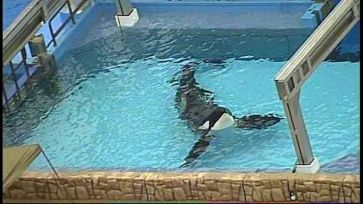







 Veg Fest Oct. 26, 2013
Veg Fest Oct. 26, 2013 DEMA Nov. 7, 2013
DEMA Nov. 7, 2013


